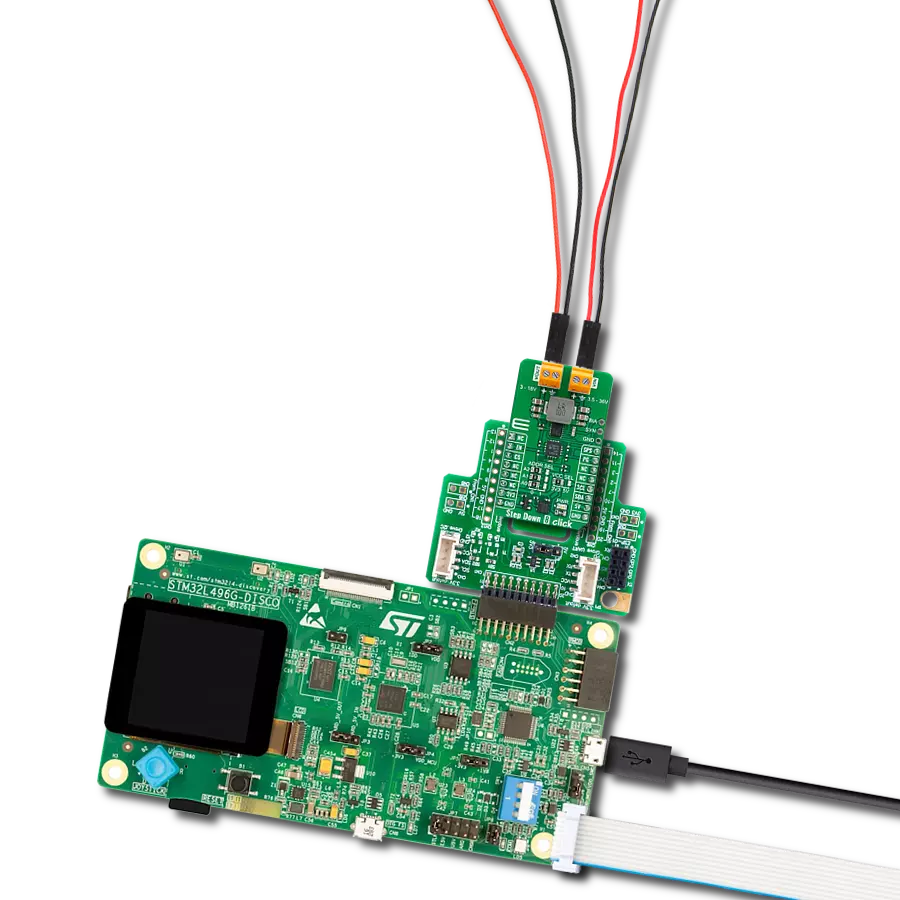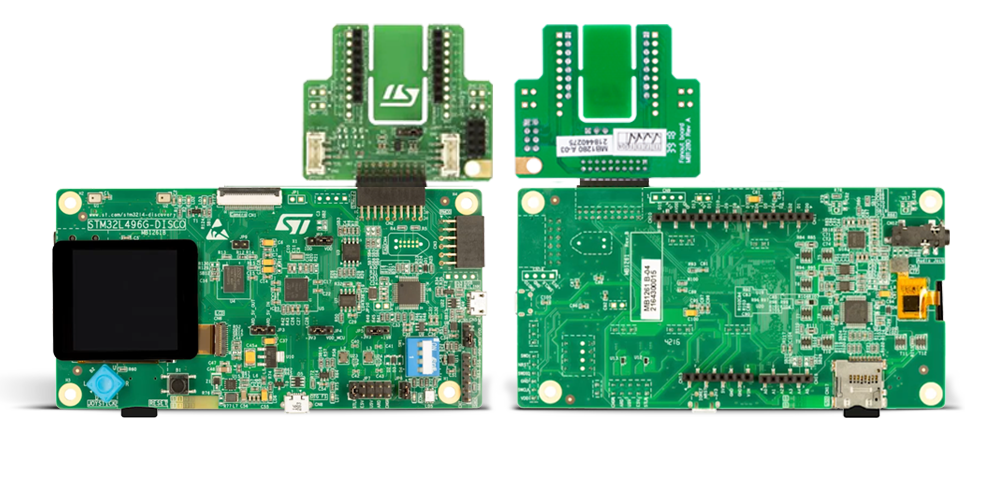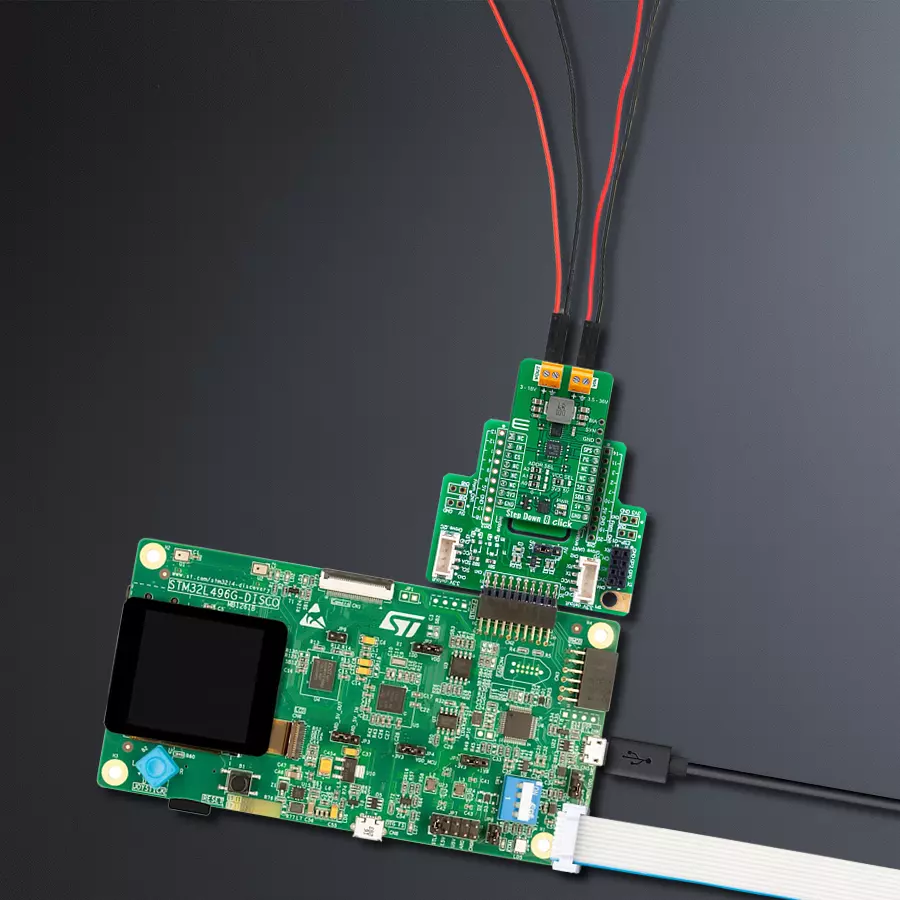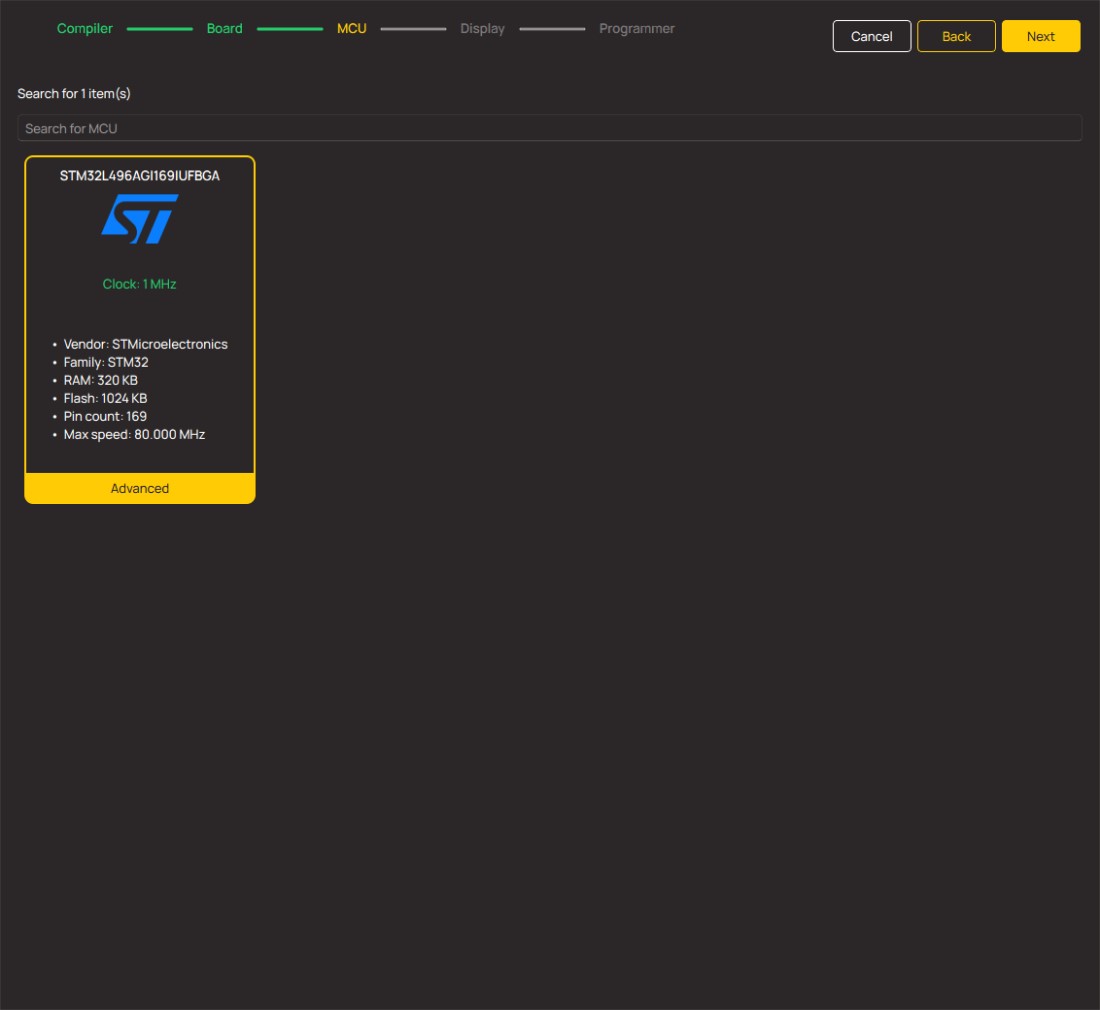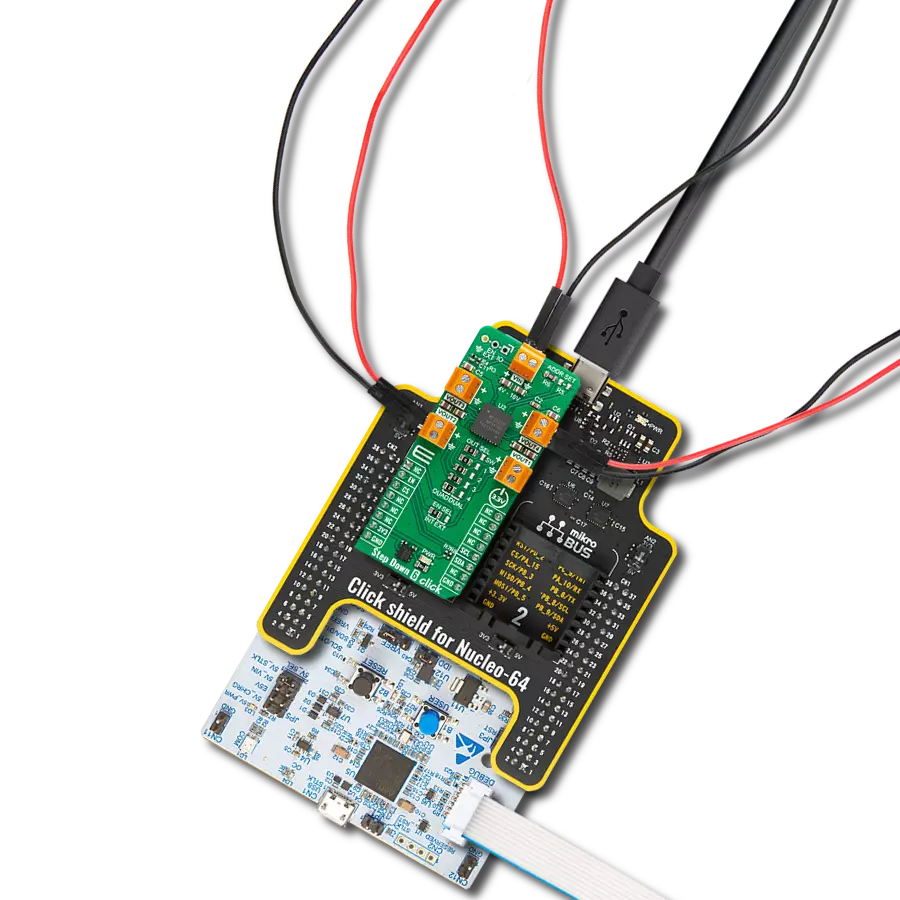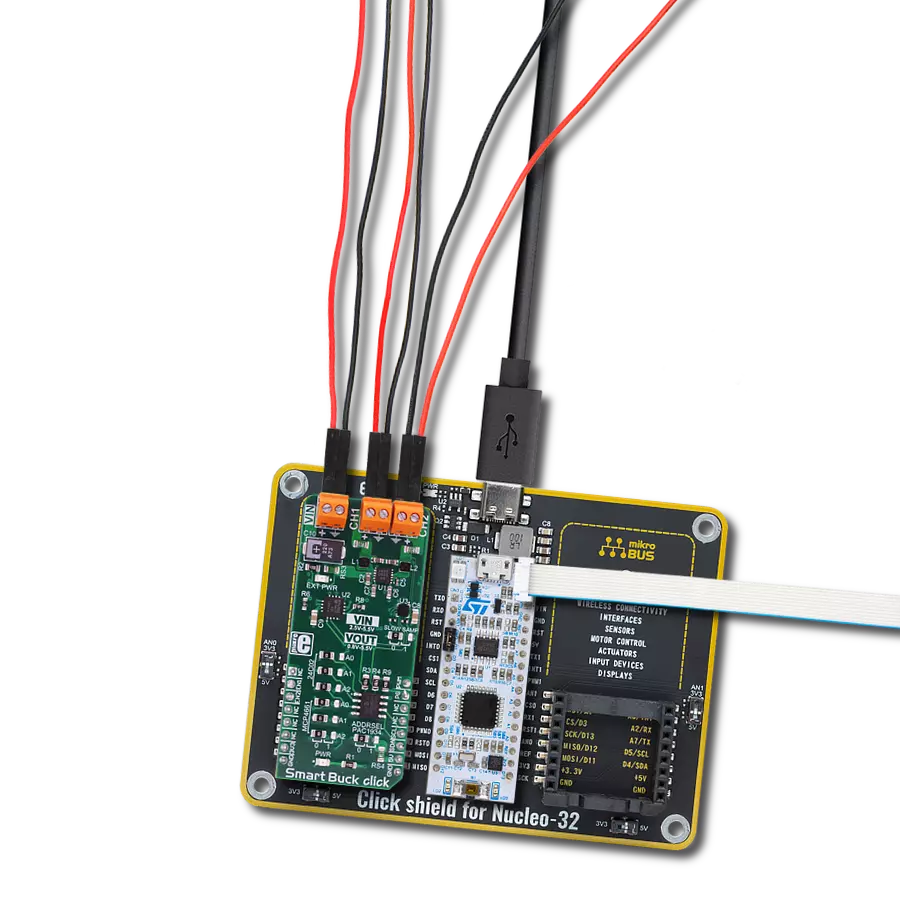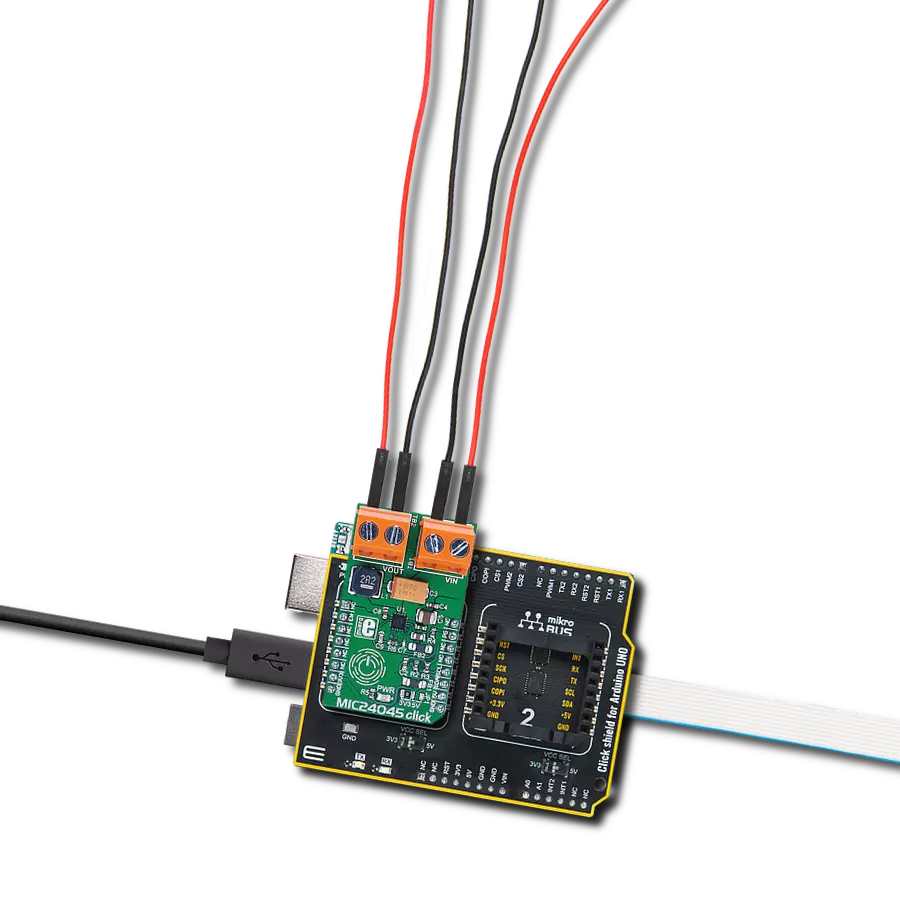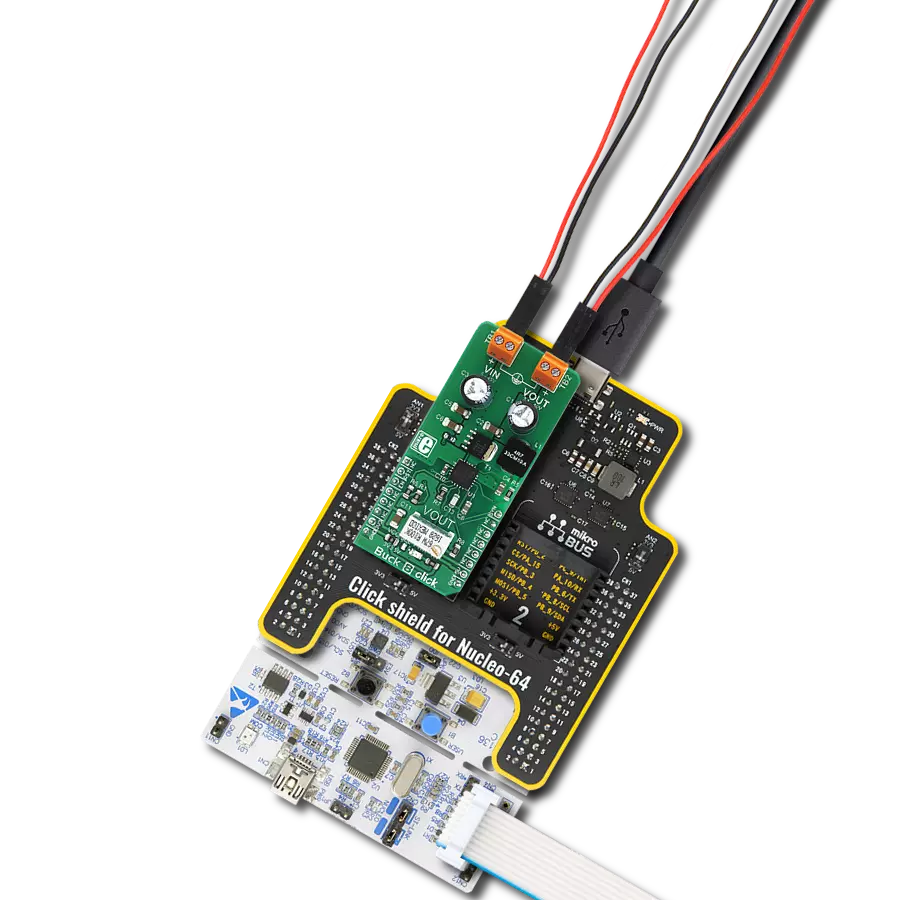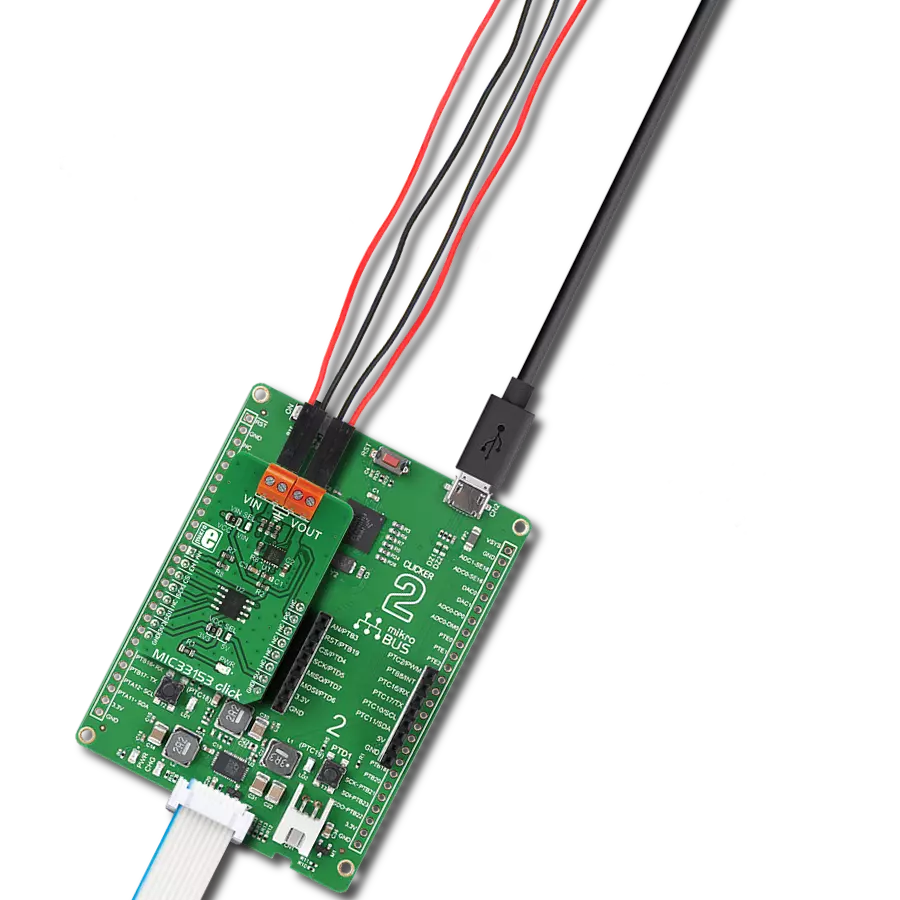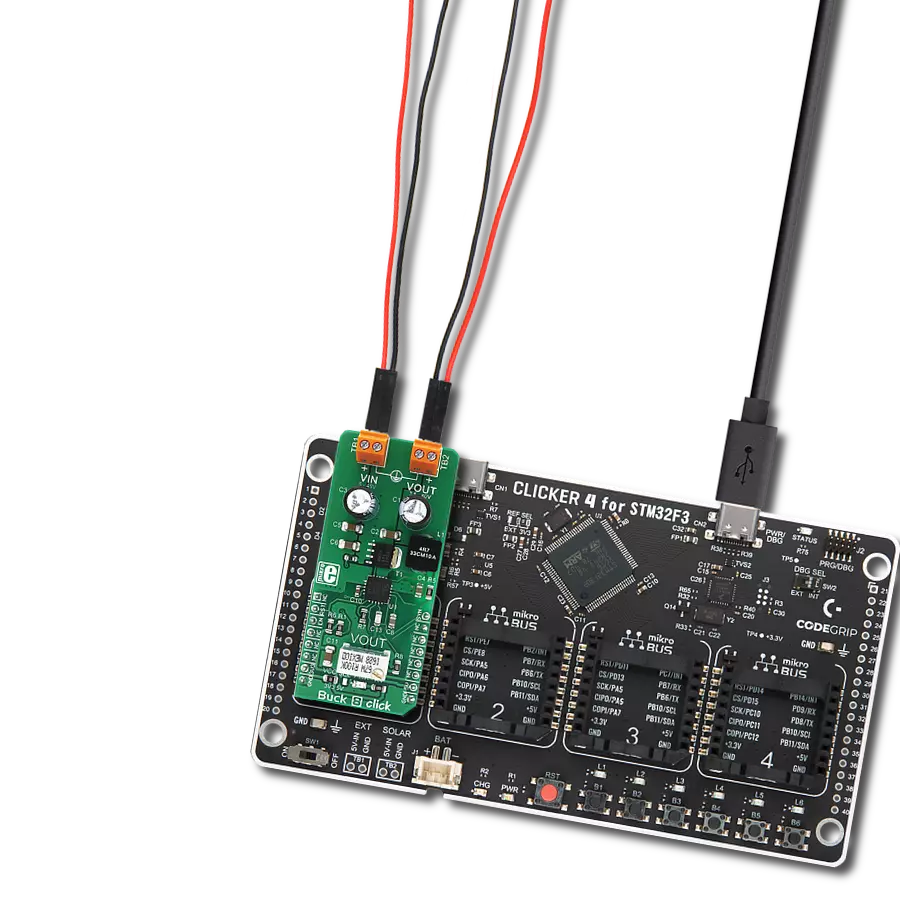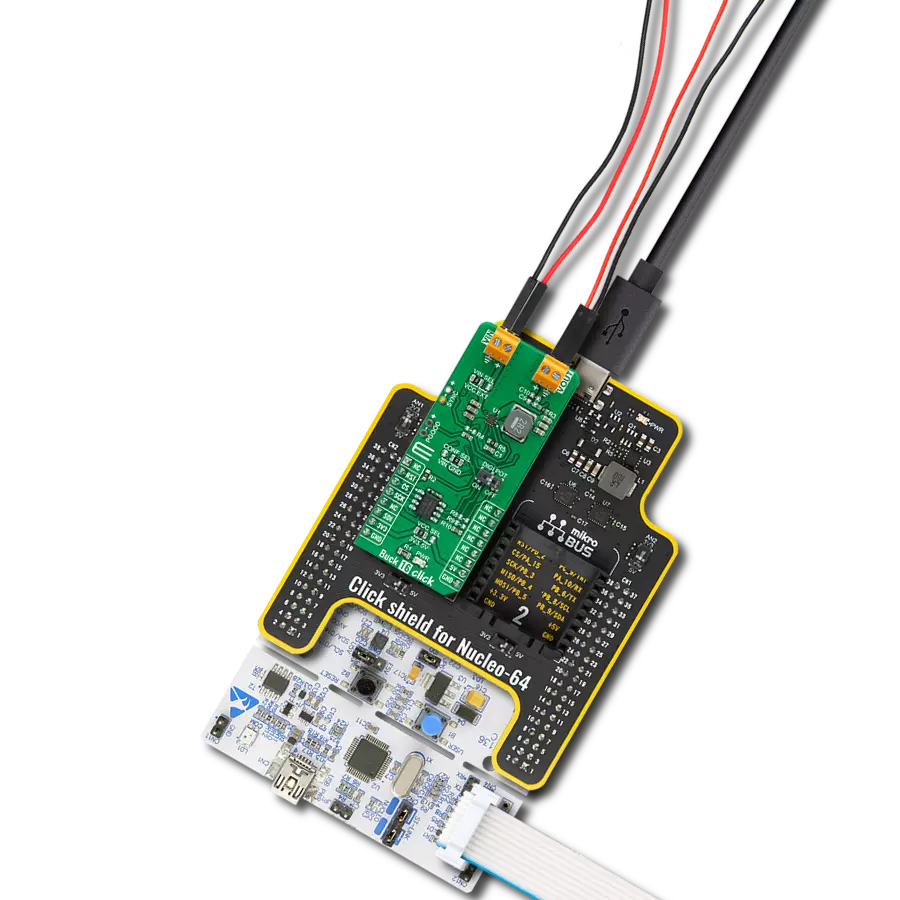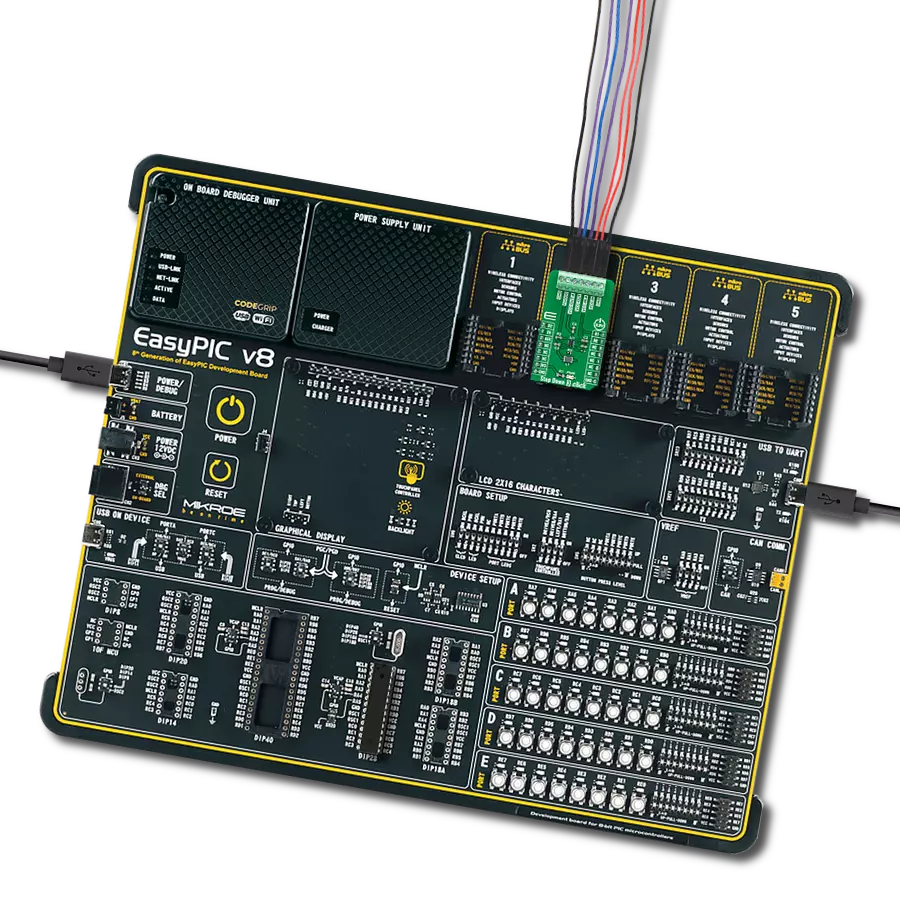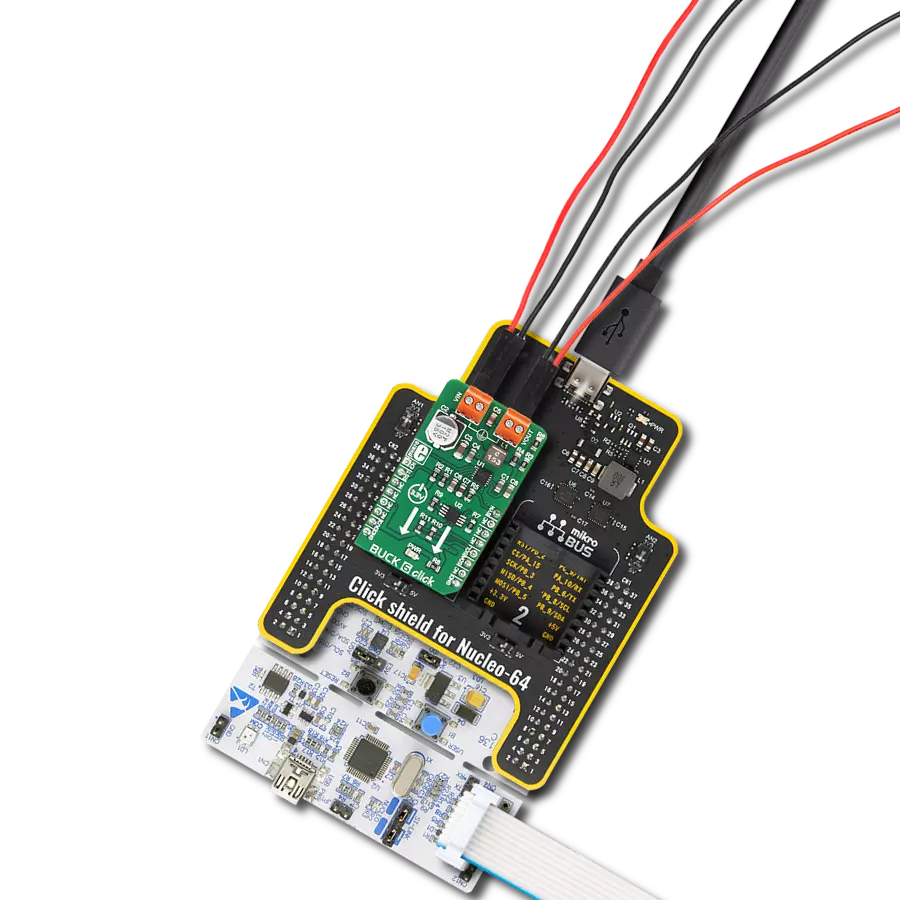Our DC-DC converter promises not just a reduction in voltage but a surge in performance for your electronic applications.
A
A
Hardware Overview
How does it work?
Step Down 8 Click is based on the MAX25232, a mini buck converter from Analog Devices. The MAX25232 features an under-voltage lockout, a soft-start timer, an on-chip oscillator, skip-mode operation, output-voltage overshoot protection, thermal-overload protection, and many more features. This current-mode-controlled buck converter operates at a 2.1MHz frequency, which guarantees no AM band interference, while it can also operate at 400KHz for minimum switching losses and maximum efficiency. While maintaining a 3A output current, it can stay in dropout by running at a 99% duty cycle. Voltage quality can be monitored by the host MCU. To set the output voltage, this Click board™ uses the MCP4661, an 8-bit I2C digital potentiometer with non-volatile memory. It comes with 256 resistors
and 257 wiper positions, while the last position is stored in an EEPROM. By setting the wiper value of resistance, you can set the output voltage of the MAX25232 converter available on the VOUT terminal. The Step Down 8 Click also features an unpopulated 3-pin header that allows you to set an operation mode. If you connect the SYNC pin to a GND or leave it unconnected, the device operates in a highly efficient pulse-skipping mode. If you connect SYNC to a BIAS pin or apply a clock to it, the device is in a forced-PWM mode (FPWM). Switching of modes can be done during the operation. Step Down 8 Click uses a standard 2-Wire I2C interface of the MCP4661 to communicate with the host MCU, supporting 100KHz, 400KHz, and 3.4MHz frequencies. The I2C address can be set over the ADDR SEL jumpers,
where the 0 position is selected by default. There is an EN enable pin to enable the converter and a PG power good pin that allows you to monitor the voltage quality. The Spread-Spectrum feature is an option that can be enabled over the SPS pin, offered to improve the EMI performance of the device. It does not interfere with the external clock applied to the SYNC pin. This Click board™ can operate with either 3.3V or 5V logic voltage levels selected via the VCC SEL jumper. This way, both 3.3V and 5V capable MCUs can use the communication lines properly. Also, this Click board™ comes equipped with a library containing easy-to-use functions and an example code that can be used as a reference for further development.
Features overview
Development board
The 32L496GDISCOVERY Discovery kit serves as a comprehensive demonstration and development platform for the STM32L496AG microcontroller, featuring an Arm® Cortex®-M4 core. Designed for applications that demand a balance of high performance, advanced graphics, and ultra-low power consumption, this kit enables seamless prototyping for a wide range of embedded solutions. With its innovative energy-efficient
architecture, the STM32L496AG integrates extended RAM and the Chrom-ART Accelerator, enhancing graphics performance while maintaining low power consumption. This makes the kit particularly well-suited for applications involving audio processing, graphical user interfaces, and real-time data acquisition, where energy efficiency is a key requirement. For ease of development, the board includes an onboard ST-LINK/V2-1
debugger/programmer, providing a seamless out-of-the-box experience for loading, debugging, and testing applications without requiring additional hardware. The combination of low power features, enhanced memory capabilities, and built-in debugging tools makes the 32L496GDISCOVERY kit an ideal choice for prototyping advanced embedded systems with state-of-the-art energy efficiency.
Microcontroller Overview
MCU Card / MCU
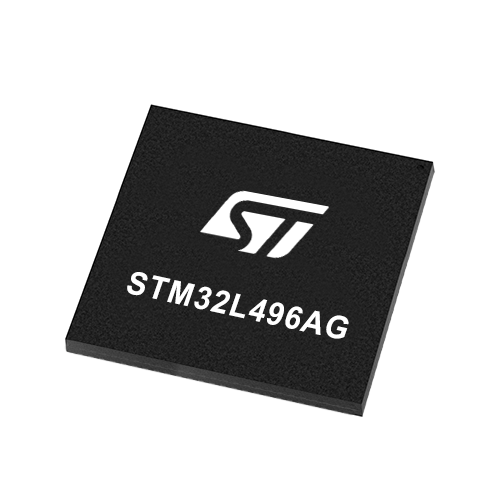
Architecture
ARM Cortex-M4
MCU Memory (KB)
1024
Silicon Vendor
STMicroelectronics
Pin count
169
RAM (Bytes)
327680
Used MCU Pins
mikroBUS™ mapper
Take a closer look
Click board™ Schematic
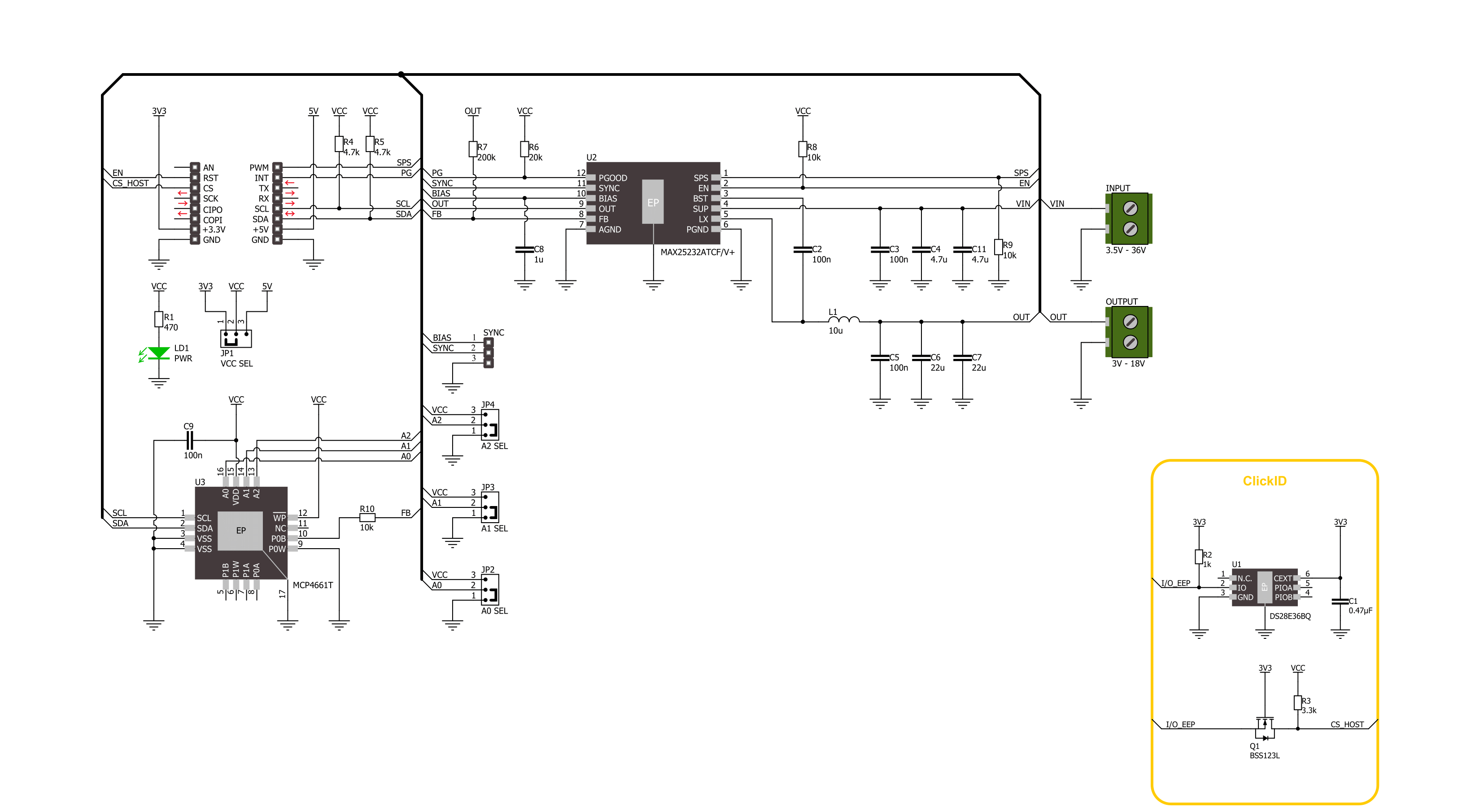
Step by step
Project assembly
Track your results in real time
Application Output
1. Application Output - In Debug mode, the 'Application Output' window enables real-time data monitoring, offering direct insight into execution results. Ensure proper data display by configuring the environment correctly using the provided tutorial.

2. UART Terminal - Use the UART Terminal to monitor data transmission via a USB to UART converter, allowing direct communication between the Click board™ and your development system. Configure the baud rate and other serial settings according to your project's requirements to ensure proper functionality. For step-by-step setup instructions, refer to the provided tutorial.

3. Plot Output - The Plot feature offers a powerful way to visualize real-time sensor data, enabling trend analysis, debugging, and comparison of multiple data points. To set it up correctly, follow the provided tutorial, which includes a step-by-step example of using the Plot feature to display Click board™ readings. To use the Plot feature in your code, use the function: plot(*insert_graph_name*, variable_name);. This is a general format, and it is up to the user to replace 'insert_graph_name' with the actual graph name and 'variable_name' with the parameter to be displayed.

Software Support
Library Description
This library contains API for Step Down 8 Click driver.
Key functions:
stepdown8_set_en_pin- Step Down 8 set EN pin state function.stepdown8_set_wiper_pos- Step Down 8 set wiper position.stepdown8_set_output- Step Down 8 set output voltage.
Open Source
Code example
The complete application code and a ready-to-use project are available through the NECTO Studio Package Manager for direct installation in the NECTO Studio. The application code can also be found on the MIKROE GitHub account.
/*!
* @file main.c
* @brief Step Down 8 Click example
*
* # Description
* This library contains API for the Step Down 8 Click driver.
* This driver provides the functions to set the output voltage treshold.
*
* The demo application is composed of two sections :
*
* ## Application Init
* Initialization of I2C module and log UART.
* After driver initialization, default settings sets output voltage to 3 V.
*
* ## Application Task
* This example demonstrates the use of the Step Down 8 Click board™ by changing
* output voltage every 2 seconds starting from 3 V up to 18 V.
*
* @author Stefan Ilic
*
*/
#include "board.h"
#include "log.h"
#include "stepdown8.h"
static stepdown8_t stepdown8;
static log_t logger;
void application_init ( void )
{
log_cfg_t log_cfg; /**< Logger config object. */
stepdown8_cfg_t stepdown8_cfg; /**< Click config object. */
/**
* Logger initialization.
* Default baud rate: 115200
* Default log level: LOG_LEVEL_DEBUG
* @note If USB_UART_RX and USB_UART_TX
* are defined as HAL_PIN_NC, you will
* need to define them manually for log to work.
* See @b LOG_MAP_USB_UART macro definition for detailed explanation.
*/
LOG_MAP_USB_UART( log_cfg );
log_init( &logger, &log_cfg );
log_info( &logger, " Application Init " );
// Click initialization.
stepdown8_cfg_setup( &stepdown8_cfg );
STEPDOWN8_MAP_MIKROBUS( stepdown8_cfg, MIKROBUS_1 );
if ( I2C_MASTER_ERROR == stepdown8_init( &stepdown8, &stepdown8_cfg ) )
{
log_error( &logger, " Communication init." );
for ( ; ; );
}
if ( STEPDOWN8_ERROR == stepdown8_default_cfg ( &stepdown8 ) )
{
log_error( &logger, " Default configuration." );
for ( ; ; );
}
log_info( &logger, " Application Task " );
}
void application_task ( void )
{
for ( uint8_t n_cnt = STEPDOWN8_MIN_OUTPUT; n_cnt <= STEPDOWN8_MAX_OUTPUT; n_cnt++ )
{
stepdown8_set_output( &stepdown8, ( float ) n_cnt );
log_printf( &logger, " Output voltage %d V\r\n", ( uint16_t ) n_cnt );
Delay_ms ( 1000 );
Delay_ms ( 1000 );
}
}
int main ( void )
{
/* Do not remove this line or clock might not be set correctly. */
#ifdef PREINIT_SUPPORTED
preinit();
#endif
application_init( );
for ( ; ; )
{
application_task( );
}
return 0;
}
// ------------------------------------------------------------------------ END
